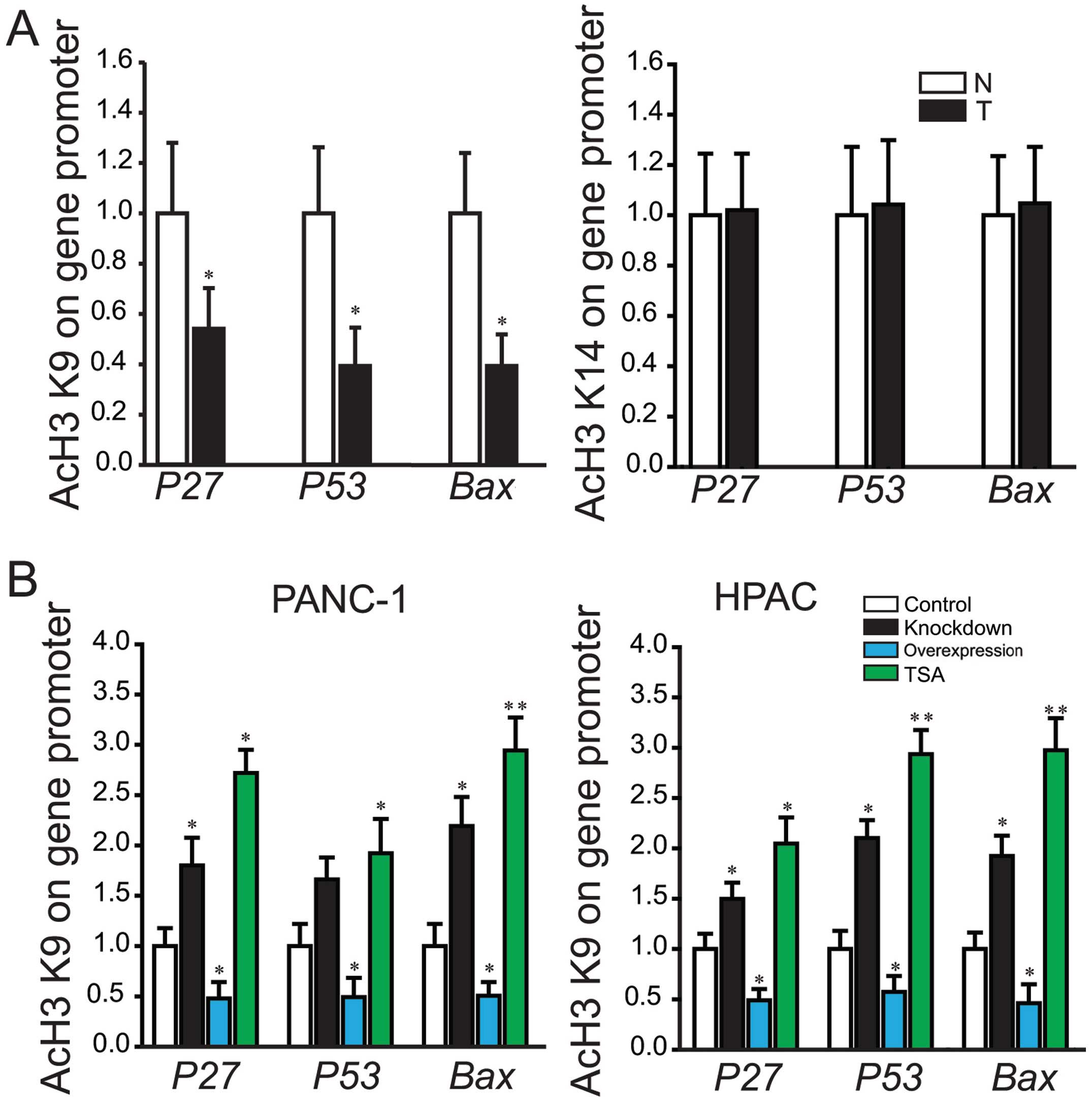|
1
|
Ducreux M, Boige V, Goere D, Deutsch E,
Ezra P, Elias D and Malka D: The multidisciplinary management of
gastrointestinal cancer. Pancreatic cancer: from pathogenesis to
cure. Best Pract Res Clin Gastroenterol. 21:997–1014. 2007.
View Article : Google Scholar : PubMed/NCBI
|
|
2
|
Ghaneh P, Costello E and Neoptolemos JP:
Biology and management of pancreatic cancer. Postgrad Med J.
84:478–497. 2008. View Article : Google Scholar
|
|
3
|
Chueh AC, Togel L, Mariadason J and Tse
JW: Mechanisms of HDAC inhibitor-regulated gene expression in
cancer cells. Antioxid Redox Signal. March 27–2014.[Epub ahead of
print].
|
|
4
|
West AC and Johnstone RW: New and emerging
HDAC inhibitors for cancer treatment. J Clin Invest. 124:30–39.
2014. View
Article : Google Scholar : PubMed/NCBI
|
|
5
|
Barneda-Zahonero B and Parra M: Histone
deacetylases and cancer. Mol Oncol. 6:579–589. 2012. View Article : Google Scholar
|
|
6
|
Huang X, Ji G, Wu Y, Wan B and Yu L:
LAMA4, highly expressed in human hepatocellular carcinoma from
Chinese patients, is a novel marker of tumor invasion and
metastasis. J Cancer Res Clin Oncol. 134:705–714. 2008. View Article : Google Scholar : PubMed/NCBI
|
|
7
|
Xue Y, Ren H, Xiao W, Chu Z, Lee JJ and
Mao L: Antitumor activity of AZ64 via G2/M arrest in non-small cell
lung cancer. Int J Oncol. 41:1798–1808. 2012.PubMed/NCBI
|
|
8
|
Giovannetti E, Del TM, Mey V, Funel N,
Nannizzi S, Ricci S, Orlandini C, Boggi U, Campani D, Del CM,
Iannopollo M, Bevilacqua G, Mosca F and Danesi R: Transcription
analysis of human equilibrative nucleoside transporter-1 predicts
survival in pancreas cancer patients treated with gemcitabine.
Cancer Res. 66:3928–3935. 2006. View Article : Google Scholar
|
|
9
|
Bardeesy N, Aguirre AJ, Chu GC, Cheng KH,
Lopez LV, Hezel AF, Feng B, Brennan C, Weissleder R, Mahmood U,
Hanahan D, Redston MS, Chin L and Depinho RA: Both p16(Ink4a) and
the p19(Arf)-p53 pathway constrain progression of pancreatic
adenocarcinoma in the mouse. Proc Natl Acad Sci USA. 103:5947–5952.
2006. View Article : Google Scholar : PubMed/NCBI
|
|
10
|
Ansari D, Rosendahl A, Elebro J and
Andersson R: Systematic review of immunohistochemical biomarkers to
identify prognostic subgroups of patients with pancreatic cancer.
Br J Surg. 98:1041–1055. 2011. View
Article : Google Scholar : PubMed/NCBI
|
|
11
|
Hamada S, Masamune A, Miura S, Satoh K and
Shimosegawa T: MiR-365 induces gemcitabine resistance in pancreatic
cancer cells by targeting the adaptor protein SHC1 and
pro-apoptotic regulator BAX. Cell Signal. 26:179–185. 2014.
View Article : Google Scholar : PubMed/NCBI
|
|
12
|
Chen Z, Chen LY, Dai HY, Wang P, Gao S and
Wang K: miR-301a promotes pancreatic cancer cell proliferation by
directly inhibiting Bim expression. J Cell Biochem. 113:3229–3235.
2012. View Article : Google Scholar : PubMed/NCBI
|
|
13
|
Genin P, Lin R, Hiscott J and Civas A:
Recruitment of histone deacetylase 3 to the interferon-A gene
promoters attenuates interferon expression. PLoS One. 7:e383362012.
View Article : Google Scholar : PubMed/NCBI
|
|
14
|
Karagianni P and Wong J: HDAC3: taking the
SMRT-N-CoRrect road to repression. Oncogene. 26:5439–5449. 2007.
View Article : Google Scholar : PubMed/NCBI
|
|
15
|
Pokholok DK, Harbison CT, Levine S, Cole
M, Hannett NM, Lee TI, Bell GW, Walker K, Rolfe PA, Herbolsheimer
E, Zeitlinger J, Lewitter F, Gifford DK and Young RA: Genome-wide
map of nucleosome acetylation and methylation in yeast. Cell.
122:517–527. 2005. View Article : Google Scholar : PubMed/NCBI
|
|
16
|
Guenther MG, Levine SS, Boyer LA, Jaenisch
R and Young RA: A chromatin landmark and transcription initiation
at most promoters in human cells. Cell. 130:77–88. 2007. View Article : Google Scholar : PubMed/NCBI
|
|
17
|
Liu C, Liu L, Shan J, Shen J, Xu Y, Zhang
Q, Yang Z, Wu L, Xia F, Bie P, Cui Y, Zhang X, Bian X and Qian C:
Histone deacetylase 3 participates in self-renewal of liver cancer
stem cells through histone modification. Cancer Lett. 339:60–69.
2013. View Article : Google Scholar : PubMed/NCBI
|
|
18
|
Minamiya Y, Ono T, Saito H, Takahashi N,
Ito M, Motoyama S and Ogawa J: Strong expression of HDAC3
correlates with a poor prognosis in patients with adenocarcinoma of
the lung. Tumour Biol. 31:533–539. 2010. View Article : Google Scholar : PubMed/NCBI
|
|
19
|
Weichert W, Roske A, Gekeler V, Beckers T,
Stephan C, Jung K, Fritzsche FR, Niesporek S, Denkert C, Dietel M
and Kristiansen G: Histone deacetylases 1, 2 and 3 are highly
expressed in prostate cancer and HDAC2 expression is associated
with shorter PSA relapse time after radical prostatectomy. Br J
Cancer. 98:604–610. 2008. View Article : Google Scholar : PubMed/NCBI
|
|
20
|
Wu LM, Yang Z, Zhou L, Zhang F, Xie HY,
Feng XW, Wu J and Zheng SS: Identification of histone deacetylase 3
as a biomarker for tumor recurrence following liver transplantation
in HBV-associated hepatocellular carcinoma. PLoS One. 5:e144602010.
View Article : Google Scholar : PubMed/NCBI
|
|
21
|
Glaser KB, Li J, Staver MJ, Wei RQ, Albert
DH and Davidsen SK: Role of class I and class II histone
deacetylases in carcinoma cells using siRNA. Biochem Biophys Res
Commun. 310:529–536. 2003. View Article : Google Scholar : PubMed/NCBI
|
|
22
|
Zhu J, Wan H, Xue C, Jiang T, Qian C and
Zhang Y: Histone deacetylase 3 implicated in the pathogenesis of
children glioma by promoting glioma cell proliferation and
migration. Brain Res. 1520:15–22. 2013. View Article : Google Scholar : PubMed/NCBI
|
|
23
|
Campos B, Bermejo JL, Han L, Felsberg J,
Ahmadi R, Grabe N, Reifenberger G, Unterberg A and Herold-Mende C:
Expression of nuclear receptor corepressors and class I histone
deacetylases in astrocytic gliomas. Cancer Sci. 102:387–392. 2011.
View Article : Google Scholar : PubMed/NCBI
|
|
24
|
Spurling CC, Godman CA, Noonan EJ,
Rasmussen TP, Rosenberg DW and Giardina C: HDAC3 overexpression and
colon cancer cell proliferation and differentiation. Mol Carcinog.
47:137–147. 2008. View
Article : Google Scholar : PubMed/NCBI
|
|
25
|
Sonnemann J, Marx C, Becker S, Wittig S,
Palani CD, Kramer OH and Beck JF: p53-dependent and p53-independent
anticancer effects of different histone deacetylase inhibitors. Br
J Cancer. 110:656–667. 2014. View Article : Google Scholar : PubMed/NCBI
|
|
26
|
Fortson WS, Kayarthodi S, Fujimura Y, Xu
H, Matthews R, Grizzle WE, Rao VN, Bhat GK and Reddy ES: Histone
deacetylase inhibitors, valproic acid and trichostatin-A induce
apoptosis and affect acetylation status of p53 in ERG-positive
prostate cancer cells. Int J Oncol. 39:111–119. 2011.
|
|
27
|
Jung KH, Noh JH, Kim JK, Eun JW, Bae HJ,
Xie HJ, Chang YG, Kim MG, Park H, Lee JY and Nam SW: HDAC2
overexpression confers oncogenic potential to human lung cancer
cells by deregulating expression of apoptosis and cell cycle
proteins. J Cell Biochem. 113:2167–2177. 2012. View Article : Google Scholar : PubMed/NCBI
|
|
28
|
Nimmanapalli R, Fuino L, Stobaugh C,
Richon V and Bhalla K: Cotreatment with the histone deacetylase
inhibitor suberoylanilide hydroxamic acid (SAHA) enhances
imatinib-induced apoptosis of Bcr-Abl-positive human acute leukemia
cells. Blood. 101:3236–3239. 2003. View Article : Google Scholar
|
|
29
|
Huang L and Pardee AB: Suberoylanilide
hydroxamic acid as a potential therapeutic agent for human breast
cancer treatment. Mol Med. 6:849–866. 2000.PubMed/NCBI
|
|
30
|
Zhao Y, Tan J, Zhuang L, Jiang X, Liu ET
and Yu Q: Inhibitors of histone deacetylases target the Rb-E2F1
pathway for apoptosis induction through activation of proapoptotic
protein Bim. Proc Natl Acad Sci USA. 102:16090–16095. 2005.
View Article : Google Scholar : PubMed/NCBI
|
|
31
|
Xu W, Ngo L, Perez G, Dokmanovic M and
Marks PA: Intrinsic apoptotic and thioredoxin pathways in human
prostate cancer cell response to histone deacetylase inhibitor.
Proc Natl Acad Sci USA. 103:15540–15545. 2006. View Article : Google Scholar : PubMed/NCBI
|
|
32
|
Reichert N, Choukrallah MA and Matthias P:
Multiple roles of class I HDACs in proliferation, differentiation,
and development. Cell Mol Life Sci. 69:2173–2187. 2012. View Article : Google Scholar : PubMed/NCBI
|














